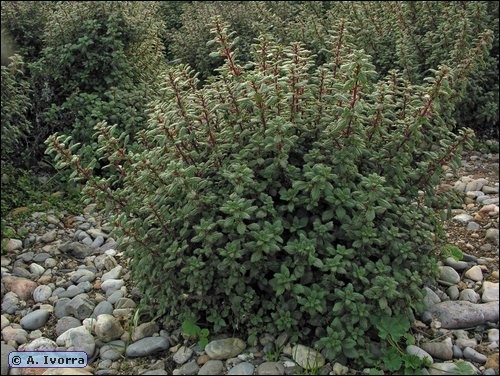
Forsskaolea tenacissima /لزيق
Caidbeja adhaerens Forssk. Forsskaolea cossoniana Webb
Lazeek, Lazzaaq, Tabaak, Hamshad
Forskaolea, Nettle Desert
Lazeek, Lazzaaq
Urticaceae

Leaves

Herbarium specimen
Ethnobotanical Characteristics
Description
A sub erect, up to 65 cm tall, hispid, woody herb. Leaves with 5-25 (-30) mm long petiole; lamina ovate-rhombic to obovate-orbicular, 1-4 (4.5) cm long, 0.7-3(3.7) cm broad, upper side with uncinate and straight hairs, lower side densely white-wooly, margin sinuate or crenate dentate, cuneate at the base; stipules ovate, 3-5 mm long, 1.5-2.5 mm broad, persistent, scarious. Involucral bracts (2-) 5 (-8), lanceolate-oblanceolate, 5-6 mm long, densely wooly. Male flowers 4-8 (-12), sub sessile, female flowers 2-6 in centre of head, sessile. Calyx unequally 3-lobed. Stamen c. 3 mm long, anther apiculate. Ovary conical-ovate, 2 mm long, surrounded by dense wool, stigma as long as ovary. Achenes ovoid-elliptic, 3 mm long, reddish-brown. (Jongbloed, 2003, e-Floras).
Habitat and Distribution
South west Europe (Southeastern Spain), North Africa, Palestine, Saudi Arabia, Iran, Afghanistan, Pakistan and India (e-Floras). Very common in mountains, especially along wadi sides near water or in damp rocky habitats. Prolific weed in east coast plantations, never in open sand (Western, 1989).
Part(s) Used
Whole plant
Traditional and Medicinal Uses
Used topically, by biting, to treat rheumatic pains. The plant is used as a cure for cough and headache in Baluchistan and is also fed to goats (e-Floras).
Pharmacognosy and Phytochemistry
Description of the Plant Parts
General appearance of dried leaf
The leaf is broadly ovate, petiolate with serrated margins, and it shrinks to a small size leaving the greenish-grey upper surface to the inside and the lower surface, which is silvery in colour to the outside. It has a coarse touch at the upper surface but a soft cotton-like touch at the lower one due to soft long covering trichomes. It is tender and thus it does not break easily in to smaller pieces.
General appearance dried stem and branches
The stem and branches are silvery white with a pink tint. Branches bear stiff covering trichomes, and leaves are found at their numerous internodes. Where leaves fall, dark brown scars are left. The branches are brittle and the epidermis and the adjacent cortical tissues separate on breaking, leaving a yellowish bark.
Microscopic characteristics
A transverse section through the leaf shows that it is dorsiventral. The upper epidermis consists of a small oval to oblong cells slightly protruding outwards into very small curves and they bear many quite long, slender fine twisting trichomes and also some very thick, warty conical tapering covering trichomes. It is underlain by one layer of densely packed palisade cells. Some of palisade cells contain rosettes of calcium oxalate. The spongy mesophyll cells are small rounded cells that surrounded conspicuous tightly packed vascular tissues whose vessels are annularly thickened. The lower epidermis consist of nearly compressed small cells that bear even more of the long slender, fine twisting covering trichomes but thick, conical trichomes of the upper epidermis are not observed.
A transverse section through a branch shows that it is semi-cylindrical. The epidermis consists of oval to rounded cells underlain by 4-5 layers of cortical parenchyma cells of irregular shapes followed by an incomplete circle of groups of non-lignified fibers with flattened cross-section and thick cell walls. These fibers surround the heavily lignified vascular tissues that occupy the middle zone followed by pith cells, which are comparatively larger, but do not have regular shapes.
Powdered plant material
The pounded aerial parts
It is a yellowish-green, heterogeneous, coarse powder with a slight pleasant aromatic odour and a flat somewhat mucilaginous taste, with a slight nasal irritant effect. Microscopically, the powder shows numerous detached covering trichomes, including very long slender ones, short thick, curved trichomes with hook-like pointed ends, and very thick, warty, tapering trichomes. Also showing some narrow, tightly packed palisade cells containing small cluster crystals of calcium oxalate, many groups of grey tracheids and groups of very long fibers.
Parts studied
leaf and stem
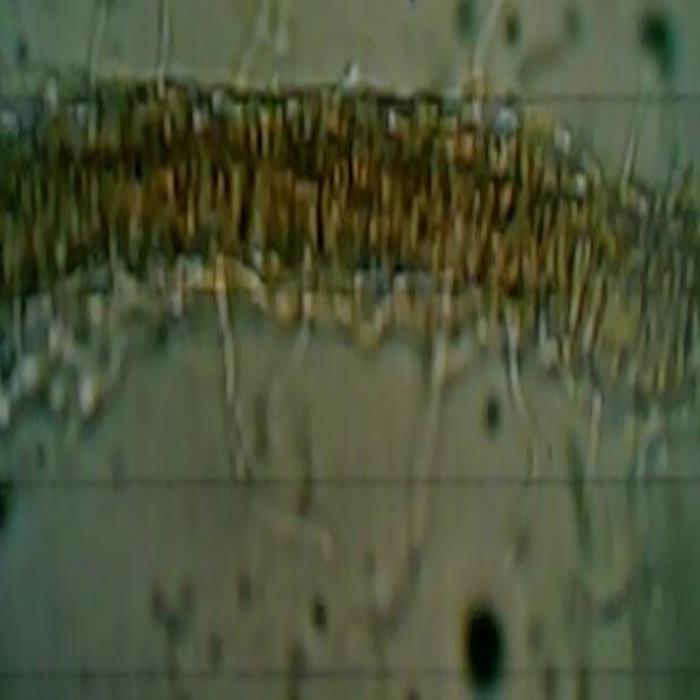
A) TS of leaf
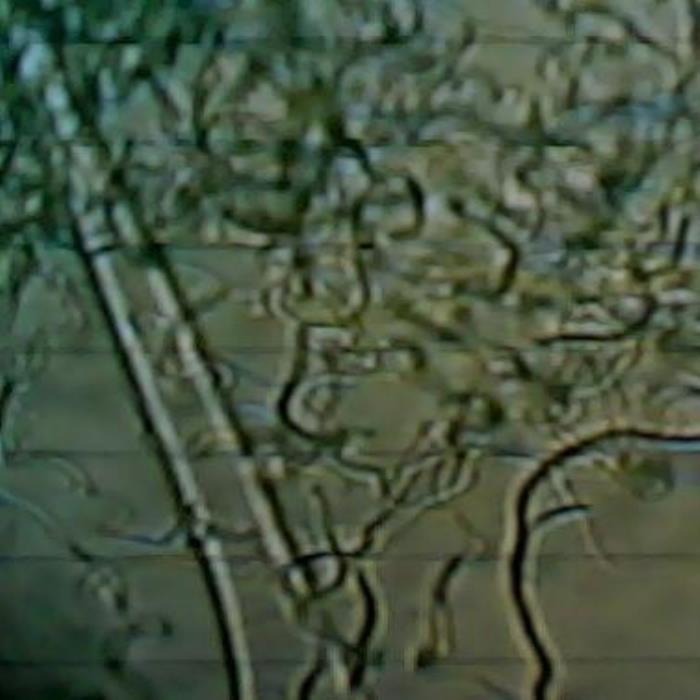
B) Upper epidermis

C) TS of stem
- A. TS through a portion of the leaf showing the upper epidermal layer bearing long slender twisting covering trichomes, underlain by a palisade layer containing calcium oxalate rosettes then the spongy mesophyll cells underlain by the lower epidermis that bear more of the long slender covering trichomes.
- B. A surface view of a portion of the upper epidermis of the leaf bearing many long slender twisting covering trichomes and a very thick warty conical covering trichome.
- C. A TS of a portion of the stem showing from left to right cortical cells, a circle of groups of non-lignified fibers that surround a zone of heavily lignified vascular tissues then the comparatively large cells of the pith.
Chemical Constituents
It contains steroids, tannins and flavonoids (flavones, flavonols or xanthones).
The following chemical studies have been carried out on the aerial part of the plant Forsskaolea tenacissima (Quality Control methods, 1998; Evans, 1996; ZCHRTM unpublished work)
Physicochemical parameters
Loss of weight in drying at 10°C : 11.10
Absolute alcohol solubility : 1.60
Water solubility : 30.60
Successive extractives (%)
Petroleum ether (60-80) °C : 0.90
Chloroform : 0.90
Absolute alcohol : 6.00
Ash values (%)
Total ash : 16.67
Water soluble ash : 2.33
Acid insoluble ash (10% HCl) : 1.67
pH values (aqueous solution)
pH of 1% solution : 8.68-8.73
pH of 10% solution : 8.38-8.41
Elemental analyses
Ash values (British Herbal Pharmacopeia)
Assay and identification of element (AOAC International)
|
Apparatus |
(AA-6800 Shimadzu-Flame method) |
||||
| Element | Std. conc. µg/ml(ppm) | Sample conc.mg/ml | Sample absorbance | Actual conc.mg/ml | Actual conc.(%) |
|
Cr |
1, 2, 4 |
10 |
0.0062 |
0.00554 |
0.000554 |
|
Zn |
0.25, 0.5, 1 |
10 |
0.1233 |
0.01065 |
0.001065 |
|
Cu |
1, 2, 4 |
10 |
0.0512 |
0.02285 |
0.002285 |
|
Fe |
1, 2, 4 |
10 |
0.7596 |
0.53801 |
0.053801 |
|
K |
1, 2, 4 |
0.5 |
0.8068 |
29.1992 |
2. 91992 |
|
Pb |
1, 2, 4 |
10 |
0.0027 |
0.00664 |
0.000664 |
|
Cd |
0.25, 0.5, 1 |
10 |
0.0000 |
0.0000 |
0.0000 |
|
Ca |
5, 10, 20 |
0.5 |
0.0608 |
39.034 |
3.9034 |
UV Spectral studies
|
Ultraviolet Spectrum (USP) |
||||
|
Apparatus |
Milton Roy Spectronic Genesys 5 Spectrophotometer - Milton Roy. |
|||
|
Sample conc. (mg / ml) |
Solvent |
λ max (nm) |
λ min (nm) |
Abs. ( λ max - λ min) |
|
1.2725 |
Intestinal Fluid simulated without pancreatic pH=7.50.1 |
283 |
268 |
0.614 - 0.605 |
|
0.99 |
Gastric Fluid simulated without pepsin pH =1.20.1 |
283 |
268 |
0.482 - 0.467 |
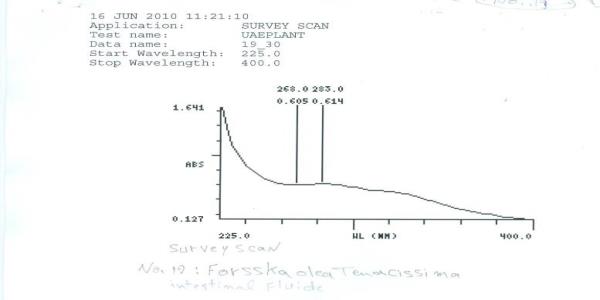
Intestinal Fluid simulated without pancreatic
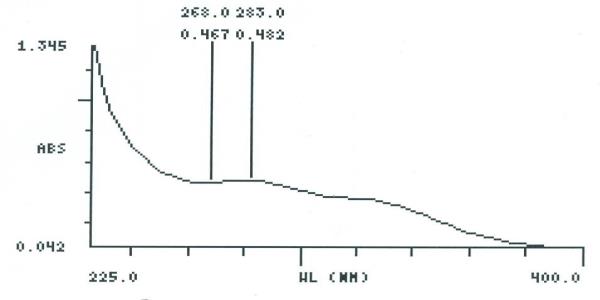
Gastric fluid simulated without pepsin
Chromatographic Studies
Thin layer chromatography (Wagner and Bladt, 1996)

A

B

C

D
TLC fingerprint of Petroleum ether –60-80°C (track 1) and Methanol extract (track 2)
|
Mobile phase Fig. |
A&D |
: |
Toluene, ethyl acetate (93:7) |
|
|
B |
: |
Ethyl acetate, methanol, water (100:13.5:10) |
|
|
C |
: |
Toluene, ethyl formate, formic acid (5:4:1) |
|
Detection |
A |
: |
UV 366nm |
|
Derivatization |
B,C&D |
: |
Vanillin-Sulphuric acid -vis |
Pharmacological and toxicological studies
Literature and reported information about the plant:
The important pharmacological and toxicological activities of the plant Forsskaolea sp. reported in various scientific journals are presented below:
Several scientific names of plants have been changed in recent years, reflecting ongoing research and classification. This plant formerly known F. cossoniana Webb belongs to the family Urticaceae. The free radical scavenging activity of longan seed extract determined by using three different assay methods. Longan extracts contained corilagin; the results demonstrate that three polyphenolics may not be the major contributors of the high antioxidant activity (Rangkadilok, 2007).
The diuretic properties attributed to three endemic species from the Canary Islands. The plants chosen were Forsskaolea angustifoli. The results confirm a diuretic activity probably due to high content of potassium salts (Pérez-Garcia, 1995).
Pharmacological studies on Forsskaolea tenacissima aqueous extract carried out at ZCHRTM Labs. (Derelanko 2002; Han, 2003).
|
ACTIVITY |
RESULTS |
|||
|
Strong |
Moderate |
Mild |
Negative |
|
|
Analgesic |
√ |
|
|
|
|
Antidepressant |
|
√ |
|
|
|
Anticonvulsant |
|
|
√ |
|
|
Anti-diabetic activity |
|
|
√ |
|
|
Gastro-protective activity |
√ |
|
|
|
|
Effect on rabbit jejunum |
|
√ |
|
|
|
Effect on rat fundus |
|
|
√ |
|
|
Effect on Guinea pig ileum |
|
|
√ |
|
|
Effect on Guinea pig tracheal chain |
|
|
|
√ |
|
Antithrombotic effect |
|
√ |
|
|
|
Effect on right rat atria |
|
|
√ |
|
|
Anesthetized rat BP & HR |
|
|
|
√ |
|
Effect on detrusor muscle |
|
√ |
|
|
|
Biochemical studies (BUN, TP, AST, ALT& CREA) ↓ |
√ |
|
|
|
|
Hematological studies (RBC, HGB & HCT) ↑ |
√ |
|
|
|
|
Locomotor activity test |
|
|
√ |
|
|
Motor co-ordination (grip strength & motor activity |
|
|
√ |
|
|
Rectal temperature |
|
|
|
√ |
|
Body weight |
|
|
|
√ |
|
Autonomic and behavioral effect |
|
|
|
√ |
Summary of Results
The plant extract showed significant anti-nociceptive activity.
The extract prolongs the onset of clonic convulsions and the death time.
The plant extract has significant effect on NaOH and Ethanol-induced gastric ulcers, and antithrombotic effect.
The extract significantly decreased the blood urea, nitrogen, creatinine, total protein, albumin, aspartate amino transferase, alanine transaminase and lactate dehydrogenase and slightly increased alkaline phosphatase.
The extract significantly increased the red blood cells count, hemoglobin concentration, and hematocrit. However, mean corpuscular volume, mean corpuscular hemoglobin means corpuscular hemoglobin concentration, and platelet showed mild increase.
The plant extract has mild sedative effect at the dose tested and did not show toxic signs.
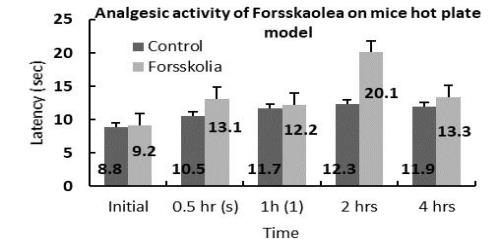
Analgesic activity on mice hot plate

Effect on gastric ulcer

Effect on AST ALT level
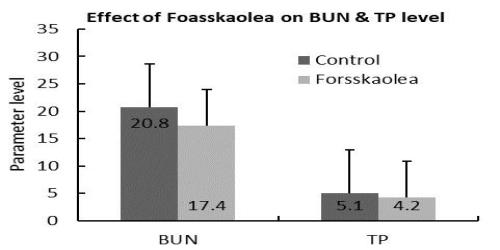
Effect on BUN TP level
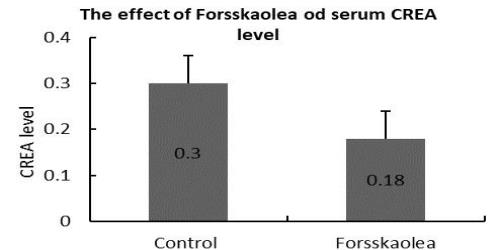
The effect on CREA level
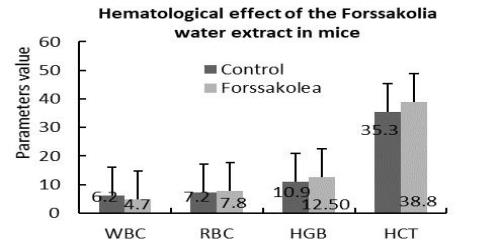
Hematological effect
Antimicrobial activity
The aqueous extract of the whole plant was tested against Mycobacterium smegmatis, C. tropicalis, different strains of Staphylococcus aureus (Including ATCC 257) as well as Methicillin Resistant Staphylococcus aureus, different strains of E. coli (Including ATCC UN 109), different strains of ESBL-producing K. pneumonia, E. coli, Pseudomonas aeruginosa and showed no inhibition of growth.
References
- A.R.Western. The flora of the United Arab Emirates – an introduction, UAE University, p.30, 1989.
- Flora of Pakistan; www.efloras.org
- Jonbloed, M. V., Feulner, G. R., Boer, B. & Western, A. R. (2003). The comprehensive Guide to the Wild Flowers of the United Arab Emirates, Erwda, Abu Dhabi, U.A.E.
- M. Pérez-García, R. M. Herrera, R. M. Rabanal, R. López-García, D. A. Martin-Herrera Diuretic Activity of Extracts from Astydamia latifolia, Forsskaolea angustifolia and Ceterach aureum in Rats Phytotherapy Research Volume 10, 1995, 6: 544 – 546
- Nuchanart Rangkadilok, Somkid Sitthimonchai, Luksamee Worasuttayangkurn, Chulabhorn Mahidol, Mathuros Ruchirawat and Jutamaad Satayavivad Evaluation of free radical scavenging and antityrosinase activities of standardized longan fruit extract. Food and Chemical Toxicology Vol. 45, 2007, 2 :328-336
- Shahina A. Gazanfar. Handbook of Arabian Medicinal Plants, CRC Press, USA, p.208, 1994.
